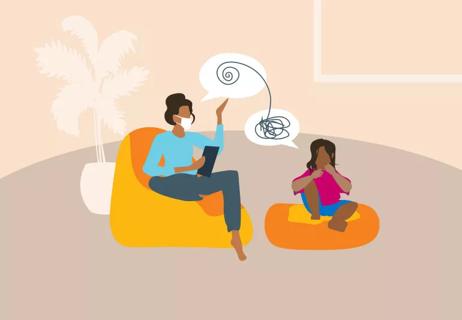Be involved in your kid’s care, but be mindful of boundaries

You want what’s best for your kids. There’s no doubt about it. So, when your child is struggling with concentrating at school or they’re withdrawing from their friends or once-favorite activities, you want to get to the root of it.
Advertisement
Cleveland Clinic is a non-profit academic medical center. Advertising on our site helps support our mission. We do not endorse non-Cleveland Clinic products or services. Policy
But we’re parents. Not mind-readers. And we’re not healthcare providers who have the training and expertise to help a child who’s struggling with their mental health.
So, you decide to make the call: It’s time to seek therapy for your child.
But what’s your role to play here? As a parent, you know there are lines you don’t cross. You know when it’s time to de-escalate an argument between your children and when to let them figure it out themselves. When to put your foot down on bedtime. And when to let certain things slide.
If children’s therapy is new to you, you may wonder what to expect. How do you advocate for your child’s well-being without helicoptering all over their therapy appointment?
We talked with pediatric psychologist Gerard Banez, PhD, for advice on the do’s and don’ts for parents and caregivers while their child is in therapy.
First and foremost, know that when you seek mental health treatment for your kid, you’re doing a good thing for them.
“People who have good mental health are happier. They’re more successful. They’re able to cope with stress and cope with their problems more effectively,” Dr. Banez says. “Good mental health improves our good quality of life and is important to our physical health, too. For kids, good mental health will help them realize their full potential.”
Advertisement
And you’re far from alone in starting therapy for your child. Research from the U.S. Centers for Disease Control and Prevention (CDC) shows how common certain mental health conditions are. Among U.S. children ages 3 to 17:
What your role will be in your child’s therapy journey will depend on a few factors, including your child’s age, the reason for therapy and the kind of therapy they’re engaged in. But Dr. Banez says that in just about all situations, some involvement from a parent should be expected.
“You can help encourage healthy patterns in between appointments if you’re in the loop,” Dr. Banez says. “Good therapy for kids has to be collaborative.”
That may mean having a briefing with the provider before or after your child’s appointment, a phone call to touch base between appointments or even joining your child for some sessions. The idea is that you should have a chance to share with the provider your perspective about any progress you’ve seen since the last appointment or any new issues that have arisen.
For younger children, you can expect to be more highly involved in their appointments.
“If I’m working with a preschooler or kindergartener, I’ll probably spend as much time with their parent as I do with their child because I can work with the parent on strategies to help the child help themselves,” Dr. Banez says.
Likewise, if parent-child conflict is an issue, you can expect to spend more time in therapy with your child. Parent-child sessions can help you understand each other better, set boundaries and strengthen your relationship.
Trust the therapist’s lead. If they invite you to a session, join. If they ask that you sit it out, trust they’ll clue you in to what you need to know.
When you’re looking for a provider, Dr. Banez suggests starting with referrals from friends, family or even your child’s school. Your child’s pediatrician can also be a particularly valuable resource for a referral. They may be able to help you identify a provider who specializes in certain evidence-based treatments or who has experience working with certain age groups.
“For some children and some mental health issues, just talking it out with a counselor will make a difference,” Dr. Banez notes. “But depending on what’s going on, there may be a very specific, targeted therapy that we know works for their condition. When you can, you’ll want to seek out providers who are specialized in the kind of care your child needs.”
Advertisement
Child psychologists may use a number of therapeutic approaches for your child, including:
Dr. Banez says some parents have a hard time discussing starting therapy with their child. Some worry that their child will feel like they’ve done something wrong. Or that they won’t agree that they need help. It’s understandable if you feel a little wary about how to start the conversation.
Some people will avoid it altogether and generically tell their child they have a “doctor’s appointment” on their way to a first therapy appointment. If your child is old enough to understand, Dr. Banez doesn’t recommend keeping therapy a secret from your child. It’s better to start things off with honest dialogue between parents and children so your kid understands what’s happening and why.
He suggests explaining to your child what you’re noticing and how you believe therapy can help. Lead with encouragement and understanding.
“You can say things like, ‘I’m concerned because you’ve seemed really sad the past few months, and I want to make sure that you get help so you don’t have to live this way,’” Dr. Banez continues. “It’s best if you can reference the problem you’re noticing, even if that can be challenging.”
Advertisement
Developing rapport with your therapist is important for anyone. In the case of children’s therapy, a “good fit” between the provider, the child and the parent is important.
“You want to be comfortable with your child’s therapist so that you feel confident they’ll tell you what you need to know. At the same time, your child needs to feel comfortable that they can speak confidentially and know their therapist won’t share more than they need to,” Dr. Banez says.
One way parents and caregivers can make sure they’re on the same page with the child’s therapist is by helping set goals at the beginning of therapy. Consider what attitude or behavioral change you hope to see in your child as a result of therapy and share that with the therapist.
Establishing a clear objective that is agreed on by the parent, child and therapist can help make sure you understand where therapy is heading, without needing to be privy to all the private conversations along the way.
As parents, we like to think we know exactly what our children need. And it can be difficult to feel like you’re left out of certain conversations.
Dr. Banez recognizes that it’s natural for well-intentioned parents to occasionally want to insert themselves a little too deeply into their children’s therapy. But that can actually derail the process.
Advertisement
“In order for therapy to work, the child has to feel like it’s theirs. They have to feel like this is for them, not just that we’re doing this because they were forced to,” Dr. Banez says.
It’s OK to engage with your child about therapy: How was your session? Is there any way I can help you right now? If they want to share, great. If they don’t, remember, that’s not an invitation to barrage them with more questions or to text the therapist demanding all the details. Trust the process.
Think about when your child started school. You weren’t with them in the classroom every day, but you probably got used to some level of communication and partnership with the adults in the room. Enough to make you feel confident that your child was well taken care of and progressing.
In some ways, the relationship with a child’s therapist is similar. You probably won’t know everything that happens in therapy. And that’s OK. But you can expect to be a partner in your child’s treatment to help encourage their progress.
Learn more about our editorial process.
Advertisement

Many claims lack science-backed research, but halotherapy is popular and considered safe

Your BFF is wonderful, but they aren’t a professional therapist

Look for comfort, fit and a feeling of partnership

Research types, find a therapist who fits you and remember — therapy isn’t a sign of weakness

Getting therapy isn't a sign of weakness

Clean your baby’s mouth with a washcloth or small toothbrush if they have a tooth or you suspect thrush

A glass child is the sibling of someone with special needs — often seen as the easy one, but carrying invisible burdens

If you’re feeling short of breath, sleep can be tough — propping yourself up or sleeping on your side may help

If you fear the unknown or find yourself needing reassurance often, you may identify with this attachment style

If you’re looking to boost your gut health, it’s better to get fiber from whole foods